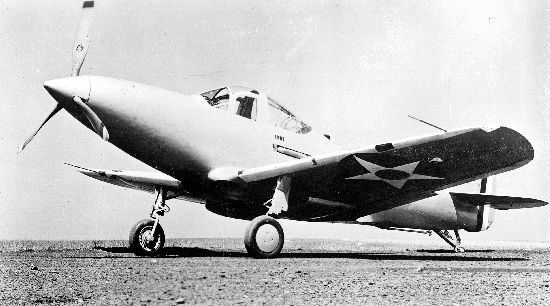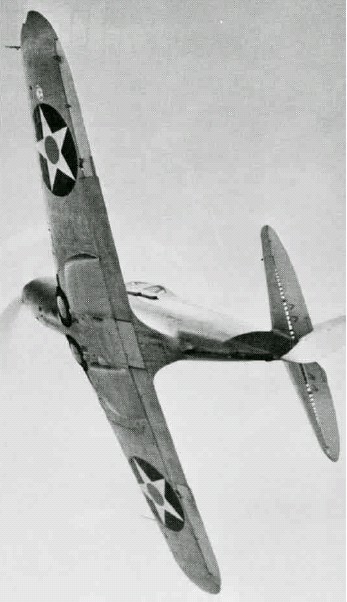Bell FL Airabonita on:
[Wikipedia]
[Google]
[Amazon]
The Bell XFL Airabonita was an American experimental

 In January 1938, the U.S. Navy issued a specification for a light carrier-based fighter to replace the obsolete biplanes then in use. On 11 April 1938, Bell, Brewster, Curtiss, Grumman, and Vought-Sikorksy submitted proposals but only three received contracts. Two of them were awarded contracts for one prototype each on 30 June 1938; these were for the
In January 1938, the U.S. Navy issued a specification for a light carrier-based fighter to replace the obsolete biplanes then in use. On 11 April 1938, Bell, Brewster, Curtiss, Grumman, and Vought-Sikorksy submitted proposals but only three received contracts. Two of them were awarded contracts for one prototype each on 30 June 1938; these were for the

carrier-based
Carrier-based aircraft, sometimes known as carrier-capable aircraft or carrier-borne aircraft, are naval aircraft designed for operations from aircraft carriers. They must be able to launch in a short distance and be sturdy enough to withstand ...
interceptor aircraft
An interceptor aircraft, or simply interceptor, is a type of fighter aircraft designed specifically for the defensive interception role against an attacking enemy aircraft, particularly bombers and reconnaissance aircraft. Aircraft that are cap ...
developed for the United States Navy
The United States Navy (USN) is the maritime service branch of the United States Armed Forces and one of the eight uniformed services of the United States. It is the largest and most powerful navy in the world, with the estimated tonnage ...
by Bell Aircraft Corporation
The Bell Aircraft Corporation was an American aircraft manufacturer, a builder of several types of fighter aircraft for World War II but most famous for the Bell X-1, the first supersonic aircraft, and for the development and production of many i ...
of Buffalo, New York. It was similar to and a parallel development of the U.S. Army Air Corps’ land-based P-39 Airacobra
The Bell P-39 Airacobra is a fighter produced by Bell Aircraft for the United States Army Air Forces during World War II. It was one of the principal American fighters in service when the United States entered combat. The P-39 was used by the ...
, differing mainly in the use of a tailwheel undercarriage
Conventional landing gear, or tailwheel-type landing gear, is an aircraft
An aircraft is a vehicle that is able to fly by gaining support from the air. It counters the force of gravity by using either static lift or by using the dynami ...
in place of the P-39's tricycle gear. Only one prototype
A prototype is an early sample, model, or release of a product built to test a concept or process. It is a term used in a variety of contexts, including semantics, design, electronics, and Software prototyping, software programming. A prototyp ...
was built.
Design and development
The XFL-1 (Bell Model 5) was powered by a single 1,150 hp (858 kW) Allison XV-1710-6 liquid-cooledV12 engine
A V12 engine is a twelve-cylinder piston engine where two banks of six cylinders are arranged in a V configuration around a common crankshaft. V12 engines are more common than V10 engines. However, they are less common than V8 engines.
The fi ...
installed amidships behind the pilot and driving a three-bladed Curtiss Electric
The Curtiss-Wright Corporation is a manufacturer and services provider headquartered in Davidson, North Carolina, with factories and operations in and outside the United States. Created in 1929 from the consolidation (business), consolidation ...
propeller
A propeller (colloquially often called a screw if on a ship or an airscrew if on an aircraft) is a device with a rotating hub and radiating blades that are set at a pitch to form a helical spiral which, when rotated, exerts linear thrust upon ...
in the nose through a 10.38 ft (3.16 m) extension shaft. The aircraft had provisions for a single 37 mm (1.46 in) Oldsmobile T9
Oldsmobile or formally the Oldsmobile Division of General Motors was a brand of American automobiles, produced for most of its existence by General Motors. Originally established as "Olds Motor Vehicle Company" by Ransom E. Olds in 1897, it produ ...
cannon
A cannon is a large- caliber gun classified as a type of artillery, which usually launches a projectile using explosive chemical propellant. Gunpowder ("black powder") was the primary propellant before the invention of smokeless powder ...
which could be replaced by a .50 in (12.7 mm) Browning M2/AN machine gun firing through the propeller shaft and two .30 in (7.62 mm) machine guns in the fuselage
The fuselage (; from the French ''fuselé'' "spindle-shaped") is an aircraft's main body section. It holds crew, passengers, or cargo. In single-engine aircraft, it will usually contain an engine as well, although in some amphibious aircraft t ...
nose. It first flew on 13 May 1940.Bowers 1979, pp. 26–30.
Although based on the P-39, the XFL-1 utilized a conventional tail-wheel undercarriage and the coolant radiators were housed externally in fairings under the wings instead of within the wing center section. The Allison engine was the first of its type to be tried out by the Navy, and lacked the turbosupercharger
In an internal combustion engine, a turbocharger (often called a turbo) is a forced induction device that is powered by the flow of exhaust gases. It uses this energy to compress the intake gas, forcing more air into the engine in order to pro ...
fitted to the XP-39.
Operational history

 In January 1938, the U.S. Navy issued a specification for a light carrier-based fighter to replace the obsolete biplanes then in use. On 11 April 1938, Bell, Brewster, Curtiss, Grumman, and Vought-Sikorksy submitted proposals but only three received contracts. Two of them were awarded contracts for one prototype each on 30 June 1938; these were for the
In January 1938, the U.S. Navy issued a specification for a light carrier-based fighter to replace the obsolete biplanes then in use. On 11 April 1938, Bell, Brewster, Curtiss, Grumman, and Vought-Sikorksy submitted proposals but only three received contracts. Two of them were awarded contracts for one prototype each on 30 June 1938; these were for the Grumman XF5F-1 Skyrocket
The Grumman XF5F Skyrocket was a prototype twin-engined shipboard fighter interceptor. The United States Navy ordered one prototype, model number G-34, from Grumman Aircraft Engineering Corporation on 30 June 1938; its designation was XF5F-1. Th ...
and the Vought XF4U-1 Corsair
The Vought F4U Corsair is an American fighter aircraft which saw service primarily in World War II and the Korean War. Designed and initially manufactured by Chance Vought, the Corsair was soon in great demand; additional production contracts ...
. The third contract, which was signed on 8 November, went to Bell Aircraft for one XFL-1 Airabonita. All three aircraft made their first flight in 1940: the XF5F-1 on 1 April, the XFL-1 on 13 May, and the XF4U-1 on 29 May.
Subsequent tests were prolonged because of difficulties with the Allison engine and problems with the balance of the aircraft. Official evaluation began in July 1940 but the XFL-1 failed to be certified for carrier operations because of main landing gear problems. The prototype was returned to Bell for modifications in December 1940 and returned to the Navy on 27 February 1941 at Naval Air Station Anacostia, District of Columbia. Based on the test results, the Navy decided not to order production of the aircraft.
In February 1942, the XFL-1 was transferred to the Aircraft Armament Unit at Naval Air Station Patuxent River, Maryland. It was later grounded, used for armament tests, and later destroyed. For many years its remains were visible at the dump at NAS Patuxent River.
As a possible further reason for the rejection, it is often stated that the Navy's position during that era was that all its aircraft should use air-cooled engines (while the Allison was liquid-cooled). This appears unfounded speculation. The U.S. Navy "would consider a liquid-cooled engine installation provided a material increase in performance over air-cooled engine can be shown."
In addition, the Allison engine had only a single-speed supercharger. Consequently, its altitude performance was much inferior to other naval fighters of the period, such as the Grumman F4F Wildcat.
Lastly, the Airabonita had to compete against the faster though not "light" Vought F4U Corsair
The Vought F4U Corsair is an American fighter aircraft which saw service primarily in World War II and the Korean War. Designed and initially manufactured by Chance Vought, the Corsair was soon in great demand; additional production contracts ...
, which in the initial F4U-1 version was capable of 390 mph at 24,000 ft.
Operators
; *United States Navy
The United States Navy (USN) is the maritime service branch of the United States Armed Forces and one of the eight uniformed services of the United States. It is the largest and most powerful navy in the world, with the estimated tonnage ...
Specifications (XFL-1 Airabonita)

See also
Notes
References
Bibliography
* Angelucci, Enzo. "The American Fighter". * Bowers, Peter M. "Airborne Cobra Pt.II". ''Airpower'', Vol. 9, No. 1, January 1979. * Dorr, Robert F. and Jerry C. Scutts. ''Bell P-39 Airacobra''. Ramsbury, Marlborough, Wiltshire, UK: The Crowood Press Ltd., 2000. . * Green, William. "Bell XFL-1 Airabonita". ''War Planes of the Second World War, Volume Four: Fighters''. London: Macdonald & Co. (Publishers) Ltd., 1961 (6th impression 1969), pp. 13–14. . * Green, William and Gordon Swanborough. "Bell XFL-1 Airabonita". ''WW2 Aircraft Fact Files: US Navy and Marine Corps Fighters''. London: Macdonald and Jane's Publishers Ltd., 1976, p. 3. . * Kinzey, Bert. "XFL-1 Airabonita". ''P-39 Airacobra - in detail''. Carrollton, Texas: Squadron/Signal Publications Inc., 1999, p. 8. . * Pelletier, A.J. "Bell Aircraft since 1935". * Thomason, Tommy. ''Bell XFL-1 Airabonita (Naval Fighters Number Eighty-One)''. Simi Valley, California: Ginter Books, 2008. . * Tomalik, Jacek. ''Bell P-6 Kingcobra, XFL-1 Airabonita, P-39 Airacobra (Monografie Lotnicze 59)'' (in Polish). Gdansk, Poland: AJ-Press, 2001. . * Wagner, Ray. "American Combat Planes Of The 20th Century". * Wixey, Ken. "Flying Cannon: Bell's Cobra Family, Part One". ''Air Enthusiast'', No. 80, May–June 1999, pp. 20–27.External links
{{USN fighters F1L 1940s United States fighter aircraft Cancelled military aircraft projects of the United States Mid-engined aircraft Low-wing aircraft Carrier-based aircraft Aircraft first flown in 1940